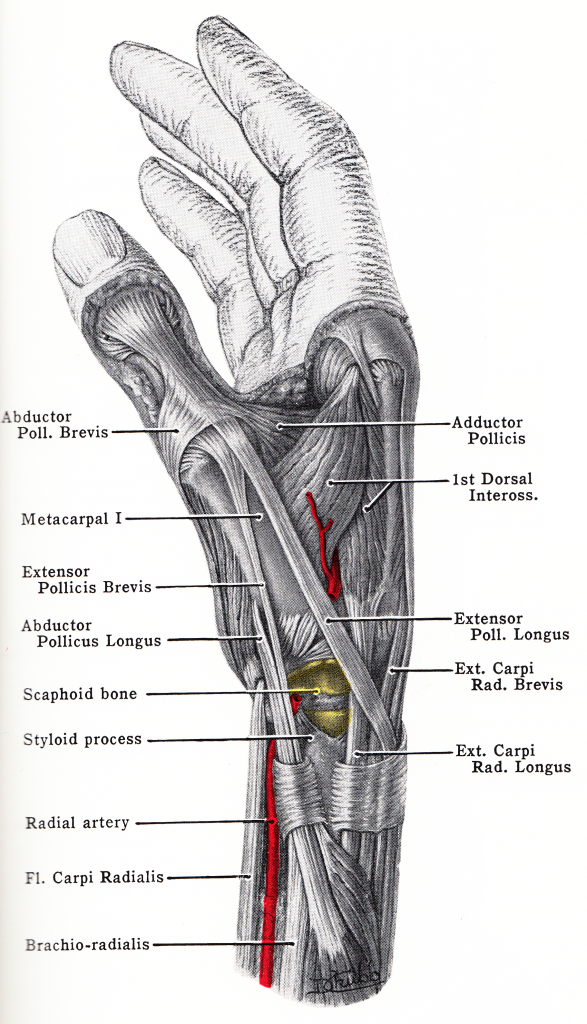
Anatomy
Upper Limb
A 54 year old man presents to the ED after tripping on a kerb. He tells you he fell onto his outstretched right hand. He complains of pain in his right wrist and on examination you note anatomical snuffbox tenderness. Which of the following structures passes through the anatomical snuffbox:
Answer:
The radial artery crosses the floor of the anatomical snuffbox lying deep to the extensor tendons of the thumb and adjacent to the scaphoid and trapezium bones. The other structures listed do not pass through the anatomical snuffbox.Anatomical Snuffbox
Anatomy / Upper Limb / Posterior Forearm
Last Updated: 10th April 2019
The anatomical snuffbox is the triangular depression formed on the posterolateral side of the dorsal wrist and 1st metacarpal by the extensor tendons passing into the thumb.
Table: Anatomical Boundaries and Contents of the Anatomical Snuffbox
| Anatomical Boundaries | Structure(s) |
|---|---|
| Medial border | Tendon of extensor pollicis longus |
| Lateral border | Tendons of the abductor pollicis longus and extensor pollicis brevis |
| Proximal border | Radial styloid process |
| Distal border | 1st metacarpal |
| Floor | Scaphoid and trapezium bones |
| Roof | Skin |
| Contents | Radial artery, terminal portion of the superficial branch of the radial nerve, cephalic vein |
Boundaries
It is bounded laterally by the tendons of the abductor pollicis longus and the extensor pollicis brevis and medially by the tendon of the extensor pollicis longus.
The floor of the anatomical snuffbox is formed by the scaphoid and trapezium carpal bones. The radial styloid process can be palpated proximally and the 1st metacarpal can be palpated distally.
Contents
The radial artery crosses the floor of the anatomical snuffbox. Subcutaneously terminal parts of the superficial branch of the radial nerve and the origin of the cephalic vein pass over the anatomical snuffbox.
The anatomical snuffbox is important clinically as the scaphoid is palpable within the snuffbox; localised pain and tenderness of the anatomical snuffbox is most likely due to a scaphoid fracture.

Anatomical Snuffbox. (Image by Grant, John Charles Boileau (An atlas of anatomy, / by regions 1962) [Public domain], via Wikimedia Commons)
Report A Problem
Is there something wrong with this question? Let us know and we’ll fix it as soon as possible.
Loading Form...
- Biochemistry
- Blood Gases
- Haematology
| Biochemistry | Normal Value |
|---|---|
| Sodium | 135 – 145 mmol/l |
| Potassium | 3.0 – 4.5 mmol/l |
| Urea | 2.5 – 7.5 mmol/l |
| Glucose | 3.5 – 5.0 mmol/l |
| Creatinine | 35 – 135 μmol/l |
| Alanine Aminotransferase (ALT) | 5 – 35 U/l |
| Gamma-glutamyl Transferase (GGT) | < 65 U/l |
| Alkaline Phosphatase (ALP) | 30 – 135 U/l |
| Aspartate Aminotransferase (AST) | < 40 U/l |
| Total Protein | 60 – 80 g/l |
| Albumin | 35 – 50 g/l |
| Globulin | 2.4 – 3.5 g/dl |
| Amylase | < 70 U/l |
| Total Bilirubin | 3 – 17 μmol/l |
| Calcium | 2.1 – 2.5 mmol/l |
| Chloride | 95 – 105 mmol/l |
| Phosphate | 0.8 – 1.4 mmol/l |
| Haematology | Normal Value |
|---|---|
| Haemoglobin | 11.5 – 16.6 g/dl |
| White Blood Cells | 4.0 – 11.0 x 109/l |
| Platelets | 150 – 450 x 109/l |
| MCV | 80 – 96 fl |
| MCHC | 32 – 36 g/dl |
| Neutrophils | 2.0 – 7.5 x 109/l |
| Lymphocytes | 1.5 – 4.0 x 109/l |
| Monocytes | 0.3 – 1.0 x 109/l |
| Eosinophils | 0.1 – 0.5 x 109/l |
| Basophils | < 0.2 x 109/l |
| Reticulocytes | < 2% |
| Haematocrit | 0.35 – 0.49 |
| Red Cell Distribution Width | 11 – 15% |
| Blood Gases | Normal Value |
|---|---|
| pH | 7.35 – 7.45 |
| pO2 | 11 – 14 kPa |
| pCO2 | 4.5 – 6.0 kPa |
| Base Excess | -2 – +2 mmol/l |
| Bicarbonate | 24 – 30 mmol/l |
| Lactate | < 2 mmol/l |

